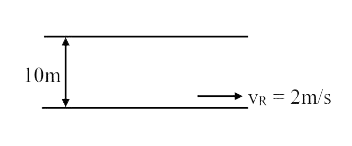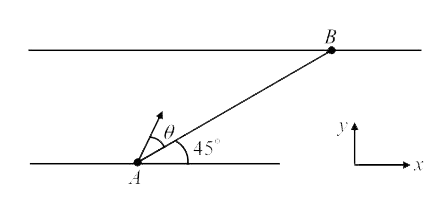A swimmer wishes to reach directly opposite bank of a river, flowing with velocity 8 m/s. The swimmer can swim 10 m/s still water. The width of the river is 480 m. Time taken by him to do so:
60 sec
48 sec
80 sec
None of these.
The correct Answer is:C
To solve the problem of the swimmer trying to reach the opposite bank of a river flowing at 8 m/s while swimming at 10 m/s in still water, we can follow these steps:
1. Identify the Given Values:
- Velocity of the river (Vr) = 8 m/s
- Velocity of the swimmer in still water (Vs) = 10 m/s
- Width of the river (d) = 480 m
2. Determine the Components of the Swimmer's Velocity:
- The swimmer must swim at an angle (θ) such that the component of his swimming velocity that counters the river's current allows him to swim directly across.
- The component of the swimmer's velocity in the direction of the river's flow is given by:
Vscos(θ)=Vr
- The component of the swimmer's velocity perpendicular to the river flow (which helps him cross) is:
Vssin(θ)
3. Set Up the Equation:
- From the first equation, we can express cos(θ):
cos(θ)=VrVs=810=0.8
- Using the Pythagorean identity, we can find sin(θ):
sin2(θ)+cos2(θ)=1
sin2(θ)+(0.8)2=1
sin2(θ)+0.64=1
sin2(θ)=0.36
sin(θ)=0.6
4. Calculate the Effective Velocity Across the River:
- The effective velocity of the swimmer in the direction across the river is:
Vcross=Vssin(θ)=10×0.6=6 m/s
5. Calculate the Time Taken to Cross the River:
- The time taken (t) to cross the river can be calculated using the formula:
t=dVcross
- Substituting the values:
t=480 m6 m/s=80 seconds
Final Answer:
The time taken by the swimmer to reach the opposite bank is 80 seconds.
---
- Velocity of the river (Vr) = 8 m/s
- Velocity of the swimmer in still water (Vs) = 10 m/s
- Width of the river (d) = 480 m
- The swimmer must swim at an angle (θ) such that the component of his swimming velocity that counters the river's current allows him to swim directly across.
- The component of the swimmer's velocity in the direction of the river's flow is given by:
Vscos(θ)=Vr
- The component of the swimmer's velocity perpendicular to the river flow (which helps him cross) is:
Vssin(θ)
- From the first equation, we can express cos(θ):
cos(θ)=VrVs=810=0.8
- Using the Pythagorean identity, we can find sin(θ):
sin2(θ)+cos2(θ)=1
sin2(θ)+(0.8)2=1
sin2(θ)+0.64=1
sin2(θ)=0.36
sin(θ)=0.6
- The effective velocity of the swimmer in the direction across the river is:
Vcross=Vssin(θ)=10×0.6=6 m/s
- The time taken (t) to cross the river can be calculated using the formula:
t=dVcross
- Substituting the values:
t=480 m6 m/s=80 seconds
The time taken by the swimmer to reach the opposite bank is 80 seconds.
Topper's Solved these Questions
- MOTION IN A STRAIGHT LINE & PLANE BOOK - VMC MODULES ENGLISHCHAPTER - MOTION IN A STRAIGHT LINE & PLANE EXERCISE - IMPECCABLE
52 Videos
- MOTION IN A STRAIGHT LINE & PLANE BOOK - VMC MODULES ENGLISHCHAPTER - MOTION IN A STRAIGHT LINE & PLANE EXERCISE - ENABLE
50 Videos
- MOCK TEST 9BOOK - VMC MODULES ENGLISHCHAPTER - MOCK TEST 9EXERCISE - PHYSICS (SECTION 2)
5 Videos
- Motion in Straight Line BOOK - VMC MODULES ENGLISHCHAPTER - Motion in Straight Line EXERCISE - IN-CHAPTER EXERCISE-J
10 Videos
Similar Questions
A swimmer can swim in still water with a speed of 2.5 m/s. What is the shortest time taken by him to swim across the river?

View SolutionA person reaches on a point directly opposite on the other bank of a river.The velocity of the water in the river is 4m/sand the velocity of the person in still water is 5m/s.If the width of the river is 84.6m, time taken to cross the river in seconds is
View SolutionA swimmer wants to directly reach the point B starting from A. The river is flowing along x-axis. If the velocity of the swimmer is √23 times the velocity of the river, find the angle θ from the line AB at which his swimming effort should be directed.

View SolutionA man can swim in still water at a speed of 4 kmph. He desires to cross a river flowing at a speed of 3 kmph in the shortest time interval. If the width of the river is 3km time taken to cross the river (in hours) and the horizontal distance travelled (in km) are respectively
View SolutionA man can swim in still water at a speed of 6 kmph and he has to cross the river and reach just opposite point on the other bank. If the river is flowing at a speed of 3 kmph, and the width of the river is 2 km, the time taken to cross the river is (in hours)
View SolutionA swimmer wishes to cross a 500m river flowing at 5kmh−1. His speed with respect to water is 3kmh−1. The shortest possible time to cross the river is.
View SolutionA swimmer wishes to cross a 500−m river flowing at 5kmh−1. His speed with respect to water is 3kmh−1. The shortest possible time to cross the river is.
View SolutionA swimmer wants to cross a 200 m wide river which is flowing at a speed of 2 m/s. the velocity of the swimmer with respect to the river is 1 m/s. how far from the point directly opposite to the starting point does the swimmer reach the opposite bank ?
View SolutionA river is flowing towards with a velocity of 5ms−1. The boat velocity is 10ms−1. The boat crosses the river by shortest path. Hence,
View SolutionA river is flowing towards with a velocity of 5ms−1. The boat velocity is 10ms−1. The boat crosses the river by shortest path. Hence,
View Solution
